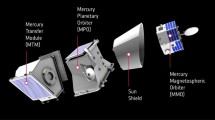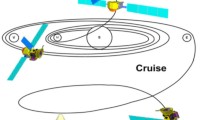Abstract
This paper presents the mission design for a Mercury Lander concept in support of NASA’s 2020 Planetary Science Decadal Survey. We evaluated both chemical and solar electric propulsion trajectory options for the interplanetary and orbital phases. Like previous missions, our solution uses a series of Venus and Mercury gravity assists to reduce the total delta-V needed to capture at Mercury. Solar electric propulsion offers significant propellant savings for the interplanetary phases, but results in unreasonably long flight times during the orbital lowering phase. Based on these trades, we selected a trajectory that uses a NEXT-C electric propulsion system with a baseline power of 9 kW to orbit match with Mercury. Upon arrival at Mercury, the electric propulsion stage is jettisoned, and a chemical system performs orbit insertion and lowering to the final orbit. Descent and landing are performed using a solid rocket motor and liquid propulsion system, respectively. The arrival is phased so that the lander can operate in local nighttime for up to 13 weeks, with direct-to-Earth communication availability for up to 7 weeks.














Similar content being viewed by others
References
Peplowski, P.N., Evans, L.G., Hauck, S.A., McCoy, T.J., Boynton, W.V., Gillis-Davis, J.J., Ebel, D.S., Goldsten, J.O., Hamara, D.K., Lawrence, D.J., et al.: Radioactive elements on Mercury’s surface from MESSENGER: Implications for the planet’s formation and evolution. Science 333(6051), 1850–1852 (2011)
Ernst, C., Chabot, N., Klima, R., Kubota, S., Byrne, P., Hauck, E.A.S.A.: A Mercury Lander Mission Concept Study for the Next Decadal Survey, 51st Lunar and Planetary Science Conference (2020)
Yen, C.-W.L.: Ballistic Mercury orbiter mission via Venus and Mercury gravity assists. J. Astronaut. Sci. 37, 417–432 (1989)
Langevin, Y.: Chemical and solar electric propulsion options for a Cornerstone Mission to Mercury. Acta Astronautica 47(2-9), 443–452 (2000)
McAdams, J.V., Dunham, D.W., Farquhar, R.W., Taylor, A.H., Williams, B.G.: Trajectory design and maneuver strategy for the MESSENGER mission to Mercury. J. Spacecraft Rock. 43(5), 1054–1064 (2006)
Casalino, L., Colasurdo, G., Rosa Sentinella, M.: Low-thrust trajectories to mercury with multiple gravity assists 43rd AIAA/ASME/SAE/ASEE Joint Propulsion Conference & Exhibit (2007)
Jehn, R., Schoenmaekers, J.: Bepicolombo Trajectory Options to Mercury in 2016 and 2017 24th International Symposium on Space Flight Dynamics (2014)
Lantukh, D.V.: Preliminary design of spacecraft trajectories for missions to outer planets and small bodies. PhD thesis The University of Texas at Austin (2015)
Lantukh, D.V., Russell, R.P., Campagnola, S.: Automated inclusion of v-infinity leveraging maneuvers in gravity-assist flyby tour design. Adv. Astronaut. Sci. 143(II), 865–884 (2012)
Hauck, S.A., Eng, D.A., Tahu, G.J.: Mercury Lander Mission Concept Study. The National Academies, USA (2010)
Ozimek, M.T., Riley, J.F., Arrieta, J.: The Low-Thrust interplanetary explorer: a Medium-Fidelity algorithm for Multi-Gravity assist Low-Thrust trajectory optimization, AAS space flight mechanics conference, no. AAS 19–348 (2019)
Sims, J.A., Flanagan, S.N.: Preliminary design of Low-Thrust interplanetary missions, AAS/AIAA astrodynamics specialist conference, girdwood, alaska, no AAS 99–338 (1999)
Gill, P.E., Murray, W., Saunders, M.A.: SNOPT: An SQP algorithm for Large-Scale constrained optimization. SIAM Rev. 47(1), 99–131 (2005)
Patterson, M.A., Rao, A.V.: GPOPS-II: A MATLAB Software for solving multiple-phase optimal control problems using hp-adaptive Gaussian quadrature collocation methods and sparse nonlinear programming. ACM Trans. Math. Softw. (TOMS) 41(1), 1–37 (2014)
Gallagher, D.: MESSENGER Solar array operations and flight data Space Power Workshop (2014)
Stall, R., Schurman, M., Sulyma, C.M., Gerger, A., Gaddy, E.: UV Degradation of space solar cell assemblies under high temperature and irradiance. In: 2018 IEEE 7th World Conference on Photovoltaic Energy Conversion (WCPEC)(A Joint Conference of 45th IEEE PVSC, 28th PVSEC & 34th EU PVSEC), IEEE, pp 3339–3343 (2018)
Driesman, A., Ercol, J., Gaddy, E., Gerger, A.: How the Parker Solar Probe Survives Close Encounters With the Sun (2019)
Klima, R.L., Denevi, B.W., Ernst, C.M., Murchie, S.L., Peplowski, P.N.: Global distribution and spectral properties of low-reflectance material on Mercury. Geophys. Res. Lett. 45(7), 2945–2953 (2018)
Anderson, P., Macdonald, M., Yen, C. -W.: Novel orbits of Mercury, Venus and Mars enabled using low-thrust propulsion. Acta Astronaut. 94(2), 634–645 (2014)
Petropoulos, A.: Low-thrust Orbit Transfers using Candidate Lyapunov Functions with a Mechanism for Coasting. AIAA/AAS Astrodynamics Specialist Conference and Exhibit 748–762 (2004)
Petropoulos, A.E.: Refinements to the Q-law for the low-thrust orbit transfers. AAS/AIAA Space Flight Mechanics Conference, Copper Mountain CO (2005)
Parker, J.S., McElrath, T.P., Anderson, R.L., Sweetser, T.H.: Trajectory Design for MoonRise: A Proposed Lunar South Pole Aitken Basin Sample Return Mission. J. Astronaut. Sci. 62(1), 44–72 (2015)
Ozimek, M.T., McGee, T.G.: Near-Optimal Guidance for precision lunar landing with a combined solid rocket motor and liquid propulsion system. 14-387 AAS/AIAA space flight mechanics conference, santa fe NM (2014)
Acknowledgments
The authors wish to acknowledge Dr. Amanda Haapala-Chalk and Dr. Chris Scott for their advice on parameterizing and conducting VILM searches.
Author information
Authors and Affiliations
Corresponding author
Additional information
Publisher’s Note
Springer Nature remains neutral with regard to jurisdictional claims in published maps and institutional affiliations.
Rights and permissions
About this article
Cite this article
Shannon, J.L., Atchison, J.A., Villac, B.F. et al. Mission Design for the 2020 Mercury Lander Decadal Survey. J Astronaut Sci 68, 995–1013 (2021). https://doi.org/10.1007/s40295-021-00280-1
Accepted:
Published:
Issue Date:
DOI: https://doi.org/10.1007/s40295-021-00280-1




